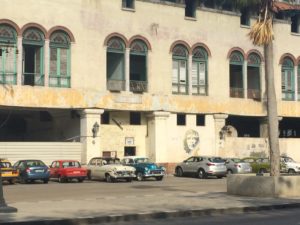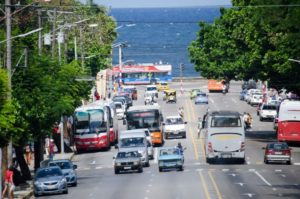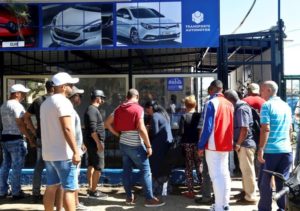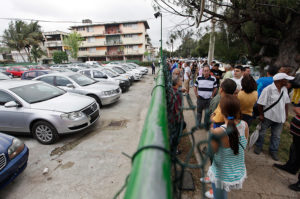 EL GOBIERNO CUBANO AUTORIZARÁ LA COMPRA DE AUTOMOVILES NUEVOS O USADOS.
EL GOBIERNO CUBANO AUTORIZARÁ LA COMPRA DE AUTOMOVILES NUEVOS O USADOS.
Cuba permitira a partir del mes de Marzo de 2020 la importacion de automoviles que les sean ofertados por la Cadena de Tiendas Caribe o las corporaciones SASA y CIMEX.
Según la funcionaria Iset M. Vazquez de CIMEX se refiere al caso específico de la importación de vehículos desde el extranjero, quizás el aspecto más novedoso dentro del paquete de medidas que impulsa el gobierno a fin de captar esas divisas frescas que tanto demanda la economía nacional.
De esta manera quedaría autorizada la importación del vehículo deseado por el comprador, nuevo o de uso, que llegaría a sus manos luego de la gestión realizada por una de las tres entidades intermediarias antes señaladas. O sea, se permite la importación de autos a personas naturales, sin embargo, solo por los canales estatales establecidos.
De la misma manera se permitirá la importación de otros productos que no estén disponibles actualmente en la red de tiendas autorizadas para la venta en Moneda Libremente Convertible (MLC), sino que se encargarán los modelos que por sus características exijan ser importados de manera personalizada.
Aunque la comercialización de autos ya se realizaba en Cuba desde el año 2014, solo se realizaba en pesos cubanos convertibles (CUC), ahora por el contrario solo se realizará en MLC estableciendo la equivalencia con el dólar estadounidense. Destaca además un descuento del 10% respecto a los anteriores costes de los automóviles, sin embargo, las cifras siguen siendo escandalosamente altas.
Ya se ha iniciado la venta de autos de segunda mano en el barrio habanero de Miramar.
Según la información oficial, desde marzo las personas naturales pueden importar diferentes autos, así como partes y piezas de repuesto automotriz a través de CIMEX, Caribe o SASA. Meisi Bolaños, ministra de Finanzas y Precios dijo que primero comenzará por La Habana y que se extenderá el servicio paulatinamente a las demás provincias. Si bien no se establece un límite geográfico, quienes no se encuentren viviendo en la capital y deseen realizar su pedido, deberán llamar a los teléfonos establecidos en las agencias habaneras de esas entidades para conocer el procedimiento a seguir:
El Gobierno se encuentra inmerso en una profunda transformación económica que tuvo su punto de inflexión en octubre del año pasado cuando se autorizó la compra de electrodomésticos de alta gama partes y piezas de automóviles y otras mercancías, a través de una cuenta bancaria en MLC.
Sin embargo, según señaló el economista cubano Pedro Monreal, el aprovechamiento de esos ingresos solo redundaría en un crecimiento económico si se tradujera en un incremento de la producción nacional, lo cual no es el caso. Dicho de otro modo, el consumo de mercancías de estas mercancías importadas estimularía directamente la producción de otros países, pero no la producción nacional. El gobierno solamente adquiriría los ingresos que grava a los costes originales de esos artículos a partir de su condición de intermediario o revendedor.
No es extraño entonces que muchos se quejen de los exagerados precios de los automóviles que se han comenzado a vender en la isla, puesto que su finalidad es enteramente recaudatoria.
Veamos algunos ejemplos:
* Mientras que un Geely CG6 se comercializa por el gobierno cubano en 35 mil 900 dólares en otros países el mismo coche no rebasa los 7 mil.
* Un Emgrand 718 que en Cuba se vende en 38 mil dólares en China solo costarí 11 mil 213 dólares.
* Con lo que un cubano puede comprarse un Renault Sandero en 40 mil dólares, en la india podría comprarse 3 autos similares y le sobrarían más de 3 mil dólares.
* Un Peugeot 301 automático de los que se ofertan en Cuba (45 mil USD) es tres veces más caro que su precio en Colombia (15 MIL 331 USD).
* Un Toyota Land Cruiser como el comprado por un cubano residente en los Estados Unidos el primer día de la venta, cuesta en Cuba 80 mil dólares, mientras que en estados unidos vale menos de la mitad de ese dinero (35 mil 997 dólares).
* Un KIA Picanto que en Colombia se compra por 10 mil 206 dólares, en Cuba cuesta 38 mil USD.
El precio de los autos que se vayan a importar se establecerá al momento de establecer el contrato entre el interesado que encarga el coche y la empresa compradora. En ese momento se pactará el precio final del servicio, y en un plazo de semanas o meses una de estas compañías cubanas entregará al comprador su coche.
 THE CUBAN GOVERNMENT WILL AUTHORIZE THE IMPORTATION OF NEW OR USED CARS.
THE CUBAN GOVERNMENT WILL AUTHORIZE THE IMPORTATION OF NEW OR USED CARS.
From March 2020, Cuba will allow the importation of cars that are offered by the Caribbean Store Chain or the SASA and CIMEX corporations.
According to the official Iset M. Vazquez of CIMEX, it refers to the specific case of the importation of vehicles from abroad, perhaps the most novel aspect within the package of measures promoted by the government in order to capture those fresh currencies that the national economy so much demands.
In this way, the importation of the vehicle desired by the new or used buyer would be authorized, which would arrive at their hands after the management carried out by one of the three intermediary entities mentioned above. That is, the importation of cars to natural persons is allowed, however, only through established state channels.
In the same way, the importation of other products that are not currently available in the network of stores authorized for sale in Freely Convertible Currency (MLC) will be allowed, but the models that, due to their characteristics, will need to be imported in a personalized manner.
Although the commercialization of cars was already carried out in Cuba since 2014, it was only carried out in Cuban convertible pesos (CUC), now, on the contrary, it will only be carried out in MLC establishing the equivalence with the US dollar. It also highlights a 10% discount with respect to previous car costs, however, the figures are still scandalously high.
The sale of second-hand cars has already begun in the Havana neighborhood of Miramar.
According to official information, since March, natural persons can import different cars, as well as automotive parts and spare parts through CIMEX, Caribe or SASA. Meisi Bolaños, Minister of Finance and Prices said that she will first start in Havana and that the service will be extended gradually to the other provinces. Although a geographical limit is not established, those who are not living in the capital and wish to place their order should call the telephone numbers established in the Havana agencies of these entities to know the procedure to follow:
The Government is immersed in a profound economic transformation that had its turning point in October last year when the purchase of high-end appliances, parts, and auto parts and other merchandise was authorized, through a bank account in MLC.
However, according to Cuban economist Pedro Monreal, the use of this income would only result in economic growth if it resulted in an increase in national production, which is not the case. In other words, the consumption of goods from these imported goods would directly stimulate the production of other countries, but not the national production. The government would only acquire the income it taxes at the original costs of those items based on its status as intermediary or reseller.
It is not strange then that many complain about the exaggerated prices of cars that have begun to be sold on the island, since their purpose is entirely tax collection.
Let’s see some examples:
* While a Geely CG6 is marketed by the Cuban government at $ 35,900 in other countries, the same car does not exceed 7,000.
* An Emgrand 718 that in Cuba sells for 38 thousand dollars in China will only cost 11 thousand 213 dollars.
* With what a Cuban can buy a Renault Sandero for 40 thousand dollars, in India 3 similar cars could be bought and more than 3 thousand dollars would be leftover.
* An automatic Peugeot 301 of those offered in Cuba (45 thousand USD) is three times more expensive than its price in Colombia (15 thousand 331 USD).
* A Toyota Land Cruiser like the one bought by a Cuban resident in the United States on the first day of the sale, costs in Cuba 80 thousand dollars, while in the United States it is worth less than half of that money (35 thousand 997 dollars).
* A KIA Picanto that is bought in Colombia for 10 thousand 206 dollars, in Cuba it costs 38 thousand USD.
The price of the cars to be imported will be established at the time of establishing the contract between the person in charge of the car and the buyer. At that time the final price of the service will be agreed, and within a period of weeks or months, one of these Cuban companies will deliver the car to the buyer.
Agencies/ Directorio Cubano/ Alex Gónzalez/ Extractos/ Excerpts/ Internet Photos/ Arnoldo Varona/ www.TheCubanHistory.com
THE CUBAN HISTORY, HOLLYWOOD.









